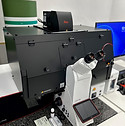
Advanced Imaging
Our advanced imaging core provides system operational training that targets different levels of users. Examples of these systems include superresolution microscopes, fluorescence microscopes and laser dissection microscopes.
Staff in charge: Ms. Crystal Lai and Ms. Angelie Shui
Confocal Imaging Systems

Stellaris is an inverted microscope for two-to-four-dimensional imaging of live or fixed specimens. Its use of adjustable white light laser and HyD detectors and its many different modules (Lightning, DSE, TauSense, Rare Event Detection, Spectraplex etc.) offer enhanced image quality and a wide range of applications for efficient and reliable quantification.

The LSM 980 confocal microscope is an inverted laser microscope for three-to-four-dimensional imaging of subcellular structures in live or fixed specimens. Along with AiryScan 2, high- and super- resolution images can be obtained at high speed without sacrificing signal-to-noise ratio.

This system provides deep imaging in biological tissues. It comes with a multi-photon laser and four high sensitivity NDD detectors for capturing rapid in vivo responses.

The SP8 confocal microscope is an inverted laser microscope for three-dimensional imaging of subcellular structures. Users can obtain ~130nm resolution images by using the built-in deconvolution software. Short-period live-cell imaging is also available with the setup of an incubation chamber.
Laser Microdissection Systems

The PALM MicroBeam laser microdissection microscope is a precise and contact-free laser microdissection system for isolating high-purity tissue, DNA, RNA and protein from fixed or live materials.
Live Cell Imaging Systems

Celldiscoverer 7 (CD7) is an automated inverted microscope with an integrated darkroom for the observation of live and fixed samples. Users can perform high-content phase-contrast and fluorescence imaging (done via LED excitation) on CD7.

The Andor spinning disk module with the Zeiss inverted microscope enables fast confocal imaging (~30 frames per second) for live cell imaging. The system can also perform FRET and photoactivation/ -conversion studies.
Super-resolution Imaging Systems

Elyra 7 is a super-resolution microscope that enables the examination of fast cellular processes in live samples – in large fields of view, in 3D, over long time periods, and with multiple colors.

The VT-iSIM High Speed Super-resolution confocal Microscope is designed for live-cell imaging and dynamic biological studies. It combines structured illumination microscopy (SIM) with spinning disk confocal technology to achieve up to 140 nm lateral resolution. The system supports imaging speeds of up to 100 frames per second, enabling real-time acquisition of fast cellular processes with minimal phototoxicity.
Widefield Imaging Systems

The CODEX System is made up of a bench-top fluidics platform and a widefield microscope to automate high parameter image acquisitions - users can image 40+ protein markers in tissue samples at single cell resolution with its 20X objective.

The Nikon fluorescence microscope is a wide-field inverted microscope with an sCMOS camera. It allows users to perform either epi-fluorescence or transmitted light imaging.

The slide scanner can generate a high volume of reproducible data (including brightfield and fluorescence images) - unattended and over long periods of time.

Unbiased stereology is recognized in biological research as the best method for quantitative histology. It is used to accurately quantify e.g. the number of cells, the length of fibers, and the area and volume of different biological structures or regions.
Offline Analysis Software

Aivia is an image analysis software with maching learning capabilities that can generate robust and reproducible segmentation results from 2D and 3D datasets, helping researchers save time on quantification. Special applications like neuron tracing and 3D object tracking are also available in this software.
